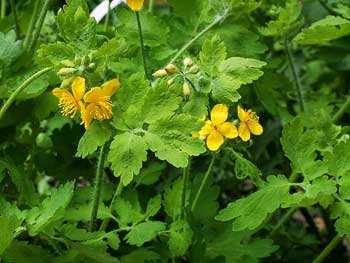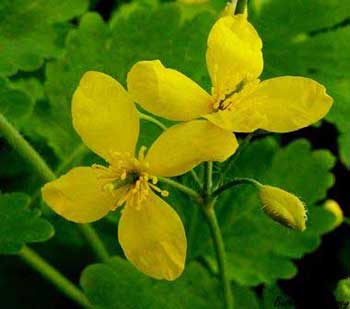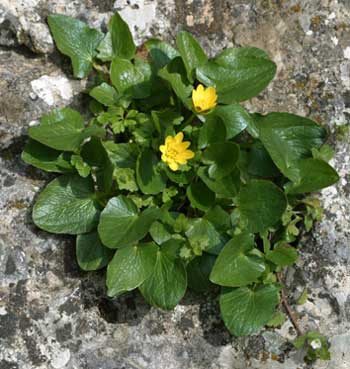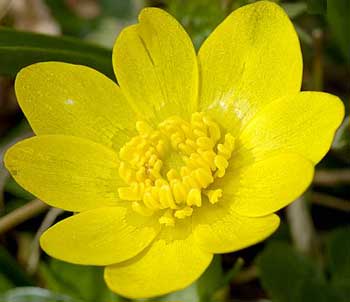Contents:
Common Names | Parts Usually Used | Plant(s) & Culture | Where Found | Medicinal Properties
Legends, Myths and Stories | Uses | Formulas or Dosages | Warning | Bibliography
Scientific Names

- Chelidonium majus L.
- Poppy family
- Papaveraceae
- Ranunculus ficaria
- (Lesser Celandine)
- Buttercup family
Common Names
Care must be taken to differentiate between two herbs known as celandine.
Greater celandine of the poppy family:
- Balsam weed
- Celendyne
- Chelidonium
- Garden celandine
- Great celandine
- Jewel weed
- Pale touch-me-not
- Slipper weed
- Snap weed
- Tetterwort
- Touch-me-not
- Weathercock
Lesser celandine of the buttercup family:
- Pilewort
Parts Usually Used
The whole herb, the fresh reddish-brown root is the part most used
Back to Top
Description of Plant(s) and Culture

Greater celandine:
This evergreen perennial herb produces a small, bright yellow flower; its stems, when broken, emit a milky sap that stains and burns the skin. Has hairy leaves shaped like oak-leaves, yellowish in color. This member of the poppy family has no connection with its better known namesake, the lesser celandine, a cousin of the buttercup. They are different medicinally and botanically.
Celandine is anchored in the soil with a strong root. Depending on the habitat, it grows 12 inches (30 cm) to over 39 inches (1 m) tall. All its parts contain a bitter, yellowish milky juice with which people try to get rid of warts and pimples. The orange-yellow juice turns red when exposed to air. Celandine stems are branching, slightly hairy, and covered with hairy alternate leaves. The hollow stem is round, smooth and swollen at the joints. The leaves are bluish-green, pinnatifid at the top and pinnate at the bottom with ovate, mildly and irregularly lobed leaflets. The bright yellow flowers have 4 petals, 1/4 to 1/2 inch across, and numerous stamens and grow in a sparse umbel. The fruit, which burst open by means of 2 valves, contains black seeds with a white appendage. The finger-thick cylindrical rootstock is red-brown on the outside, orange-yellow inside, contains the bitter, milky juice. Celandine blooms from March to the end of November: the primary blooming season is during the months of May and June.
Lesser celandine:
This is the better known herb by the name of celandine. The bright yellow flowers grace the hedgerow every spring. Its leaves are heart-shaped and often speckled with blobs of black or purple. Of more interest is the root, which sprouts a number of cylindrical tubers; these pile-like nodules were taken to suggest that the plant might cure hemorrhoids, hence its other name, the pilewort. Flowers March to April.
Back to Top
Where Found

Greater celandine:
Found in hedgerows and wastes. Introduced into this country from Europe, it now grows principally along walls, paths, and fences and in landfills. Celandine seeds have an appendage that ants find delicious, so they carry the seeds and plants can be found anywhere as a result.
Celandine is not highly recommended for growing in the backyard garden. If it finds its own way in and turns up along fences or old garden walls, count on its appearance every year, since it is a perennial.
Lesser celandine:
Found in moist corners of fields and places that are near water, yet will grow in drier ground if it is slightly sandy.
Back to Top
Medicinal Properties
Alterative, antispasmodic, cathartic, caustic, diaphoretic, diuretic, expectorant, purgative, vulnerary
Back to Top
Legends, Myths and Stories
Chelidonium majus has been used in medicine for an extremely long time. In the writings of the Greek philosopher Theophrastus (372-287 BC), he tells that celandine is useful in treating jaundice, liver disease, constipation, and gallstones. These findings also entered into the medieval herbals, from which folk medicine draws its knowledge.
Back to Top
Uses

Greater celandine:
Celandine was used in folk remedies to relieve abdominal distress; and is currently being tested as a cancer drug.
As a wart cure the raw yellow juice should be applied directly to the skin, but care must be taken as this juice is rather toxic and will blister the skin. Skin can be neutralized with diluted vinegar and water.
It is necessary to point out that celandine tea by itself is seldom used any more. Instead, celandine is an active ingredient of teas for the stomach, intestinal tract, gonorrhea, constipation, cough, gallstones, neuralgia, chorea, diarrhea, rheumatism, nose bleed, pneumonia, whooping cough, jaundice, and liver. The fresh juice mixed with vinegar may be applied for removal of warts and corns. It may also be made into an ointment to be used on various skin diseases, such as ringworm, eczema, tetters, skin cancers, and skin tuberculosis.
Lesser celandine:
Despite doubtful reasoning, it remains true that an ointment prepared from the crushed root will stop the discomfort from piles. For extra benefit, add stonecrop (Sedum album) or toadflax to the ointment. The same preparation will also heal boils, old wounds, ulcers, scrofula, sores, and painful whitlows (a painful infection at the end of a finger or toe near the nail). As the name pilewort suggests, this herb treats hemorrhoids.
Back to Top
Formulas or Dosages
The following is for greater celandine:
Gather the rootstock in spring, before the plant flowers. Use with extreme caution; preferably with medical direction. The dried plant is less active than the fresh.
Infusion: use 1 level tsp. rootstock or herb with 1 cup boiling water; steep for 30 minutes. Drink cold, 1/2 cup per day.
Tincture: a dose is 10-15 drops.
Juice: for warts, dab no more than 2 or 3 warts at a time with fresh juice, 2 to 3 times per day.
Back to Top
Warning
Do not give this herb to children.
Do not confuse greater celandine with the small or lesser celandine herb.
Greater celandine:
Strong doses are harmful, due to the caustic properties of the plant.
Skin poisoning has been reported from handling the crushed plant.
Toxic: Stem juice highly irritating, allergenic, may cause paralysis. Its use is not recommended without medical supervision.
Back to Top
Bibliography
![]() Back to Eden
Back to Eden, by Jethro Kloss; Back to Eden Publishing Co., Loma Linda, CA 92354, Original copyright 1939, revised edition 1994
![]() The Herb Book
The Herb Book, by John Lust, Bantam Books, 666 Fifth Avenue, New York, NY. copyright 1974.
![]() The Herbalist Almanac
The Herbalist Almanac, by Clarence Meyer, Meyerbooks, publisher, PO Box 427, Glenwood, Illinois 60425, copyright 1988, fifth printing, 1994
![]() The Complete Medicinal Herbal
The Complete Medicinal Herbal, by Penelope Ody, Dorling Kindersley, Inc, 232 Madison Avenue, New York, NY 10016, First American Edition, copyright 1993
![]() Culpeper’s Complete Herbal & English Physician: Updated With 117 Modern Herbs
Culpeper’s Complete Herbal & English Physician: Updated With 117 Modern Herbs, by Nicholas Culpeper, Meyerbooks, publisher, PO Box 427, Glenwood, Illinois 60425, 1990, (reprint of 1814)
![]() Indian Herbalogy of North America
Indian Herbalogy of North America, by Alma R. Hutchens, Shambala Publications, Inc., Horticultural Hall, 300 Massachusetts Avenue, Boston, Massachusetts 02115, 1973
![]() Eastern/Central Medicinal Plants
Eastern/Central Medicinal Plants, by Steven Foster and James A. Duke., Houghton Mifflin Company, 215 Park Avenue South, New York, NY 10000
![]() The Nature Doctor: A Manual of Traditional and Complementary Medicine
The Nature Doctor: A Manual of Traditional and Complementary Medicine, by Dr. H.C.A. Vogel; Keats Publishing, Inc., 27 Pine Street (Box 876) New Canaan, CT. 06840-0876. Copyright Verlag A. Vogel, Teufen (AR) Switzerland 1952, 1991
Herbal Gardening, compiled by The Robison York State Herb Garden, Cornell Plantations, Matthaei Botanical Gardens of the University of Michigan, University of California Botanical Garden, Berkeley., Pantheon Books, Knopf Publishing Group, New York, 1994, first edition
![]() American Folk Medicine
American Folk Medicine, by Clarence Meyer, Meyerbooks, publisher, PO Box 427, Glenwood, Illinois 60425, 1973
![]() Webster’s New World Dictionary
Webster’s New World Dictionary, Third College Edition, Victoria Neufeldt, Editor in Chief, New World Dictionaries: A Division of Simon & Schuster, Inc., 15 Columbus Circle, New York, NY 10023
 An Instant Guide to Medicinal Plants
An Instant Guide to Medicinal Plants, by Pamela Forey and Ruth Lindsay, Crescent Books (January 27, 1992).
 The Rodale Herb Book: How to Use, Grow, and Buy Nature’s Miracle Plants (An Organic gardening and farming book)
The Rodale Herb Book: How to Use, Grow, and Buy Nature’s Miracle Plants (An Organic gardening and farming book), edited by William H. Hylton, Rodale Press, Inc. Emmaus, PA, 18049., 1974
 The Healing Plants
The Healing Plants, by Mannfried Pahlow, Barron’s Educational Series, Inc. 250 Wireless Blvd., Hauppauge, NY 11788, 1992
